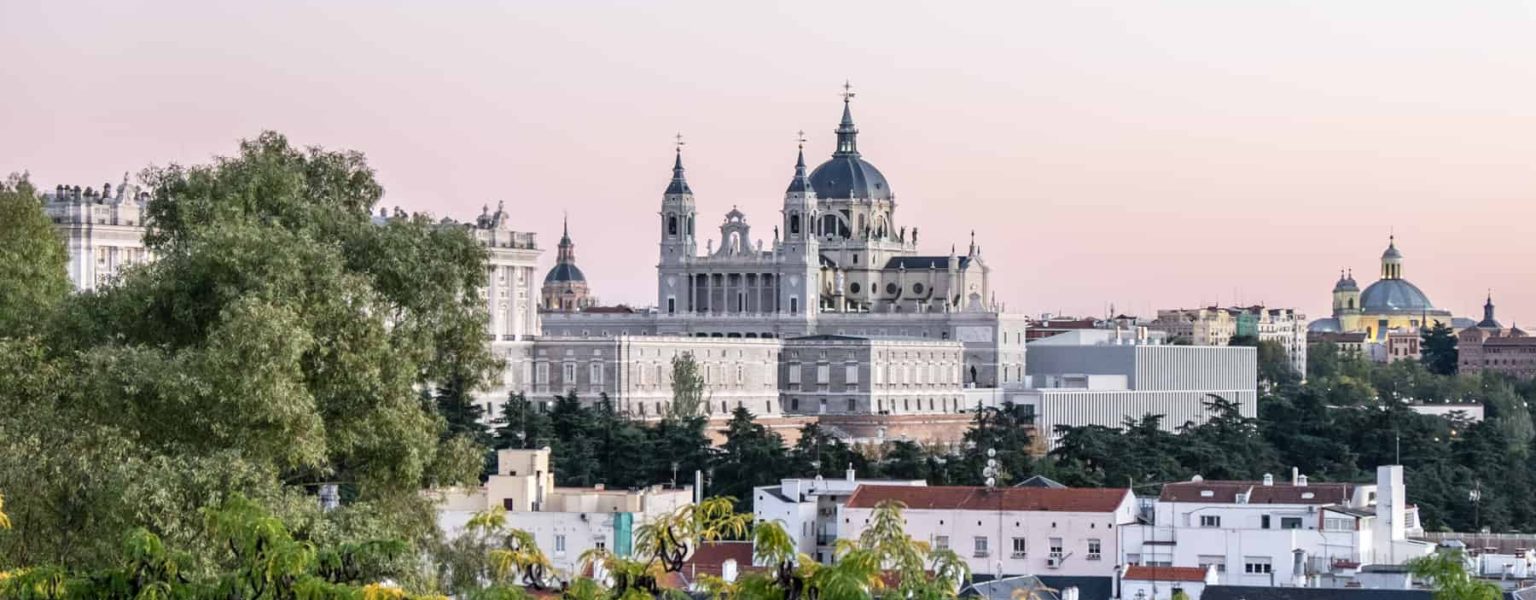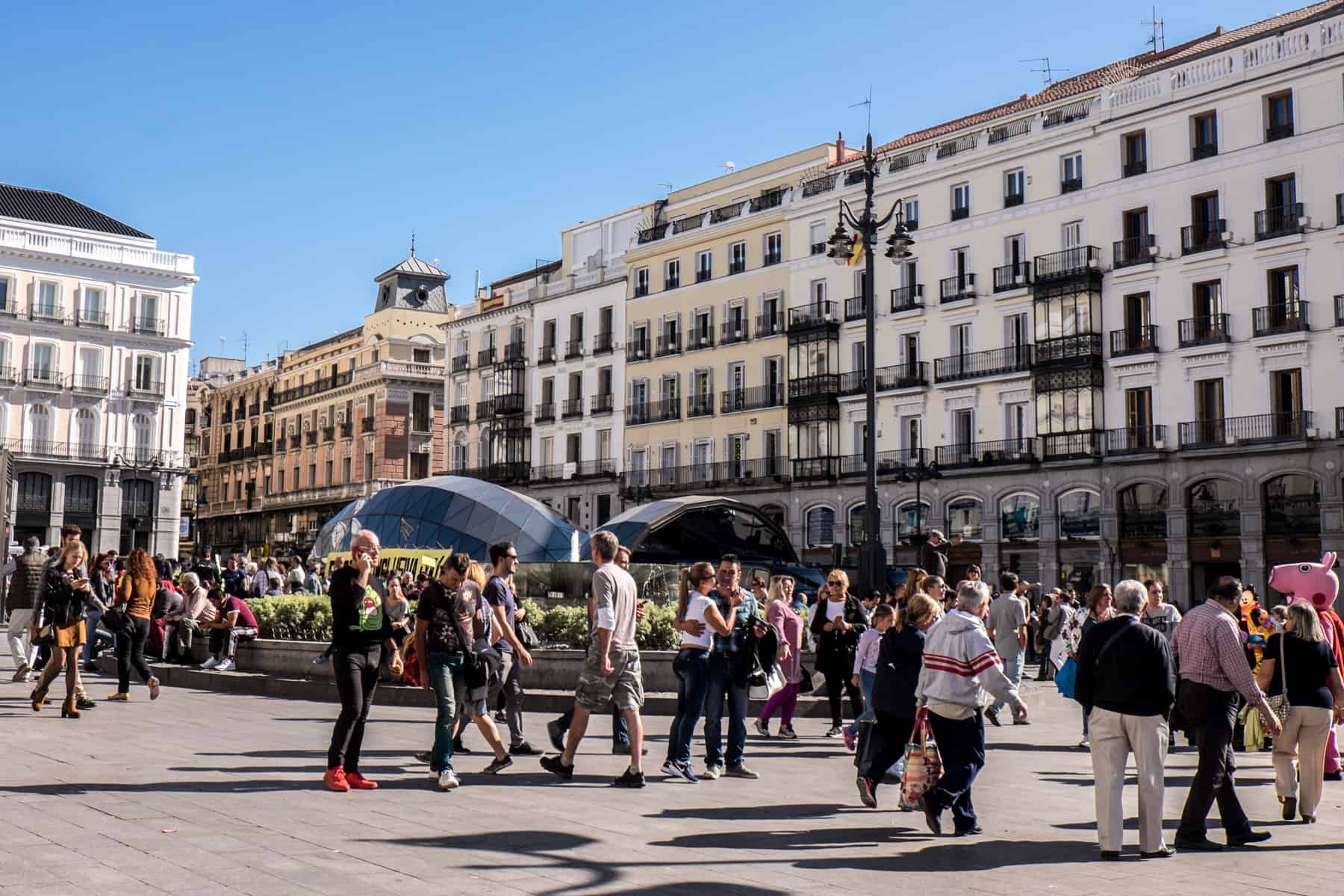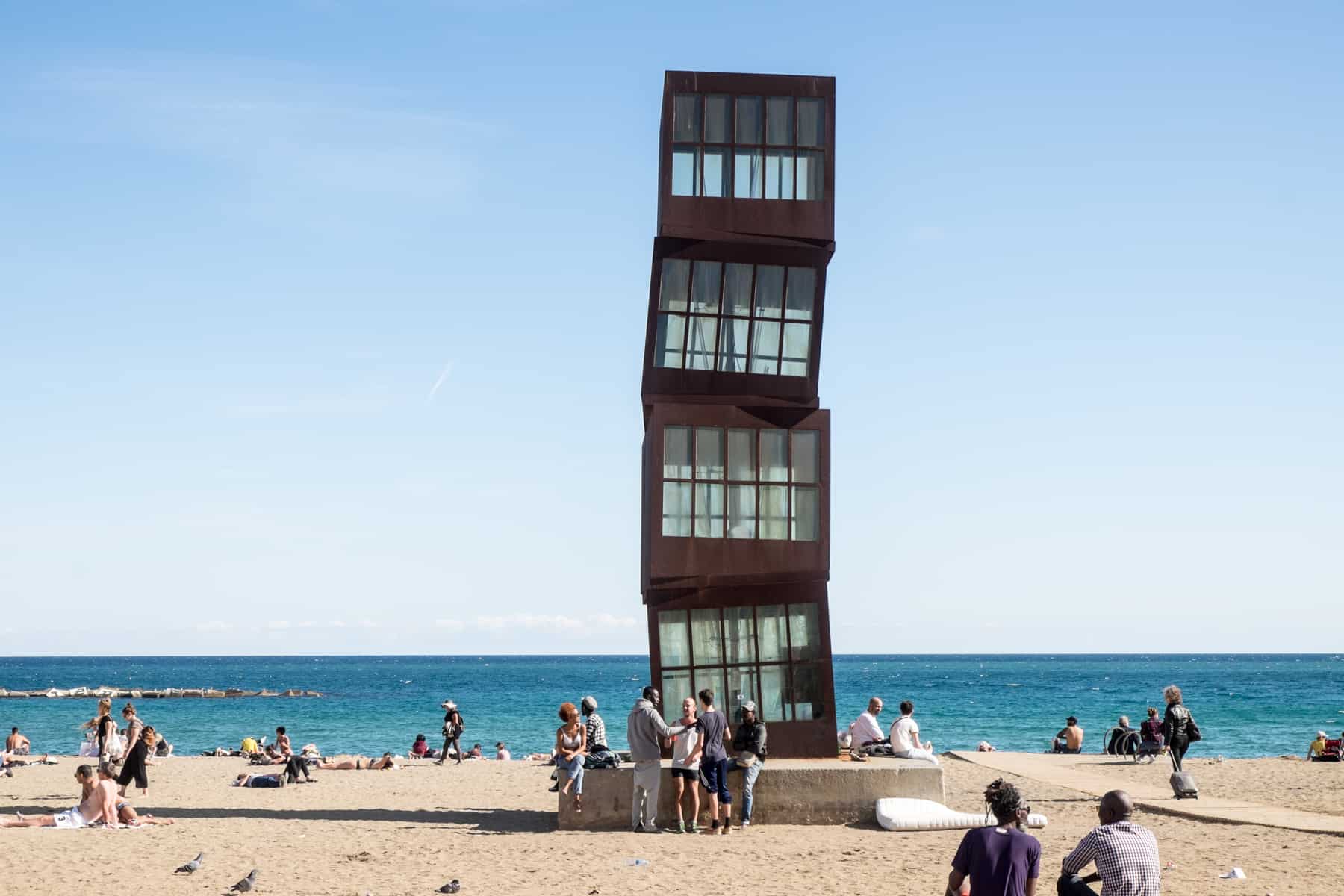Is It your first time looking for the amazing tourist attractions located in Spain? Madrid city not only has remarkable skyscrapers but is also a home for averIdeal trekking begins in a central capital city! With Madrid situated as the heart of the country, visitors can easily start their journeys to any regions of their choice. Spain is divided into 17 regions and all are equally enthusiastic.
In Spain, frequently referred to as the second telephonic country after France, the reason being renowned for its second place is its excellent infrastructure. The Renfe “Spanish High Speed” AVE train network facilitates traveling to various parts of the country using their train. The ease of traveling not only enhances tourism but also aids in beginning from Madrid, Sanchez for the north coast, and further 8 hours all the way through to Malaga the South. Unlike traveling by road, using a country train allows one to move from western Salamanca to Castellon de la Plana in 6 hours. Madrid Atocha is also the most popular station interchange lying at the most hub center.
Aside from Madrid, the other cities in Spain are the ones that make the most travelable sense given how much time and money I have. To ease the selection burden I personally rounded up the city trips by train from Madrid that are the most popular on the Renfe rail site alongside the most remarkable places to go in Spain that encapsulates Spain’s culture, history, and landscapes.
I am looking forward to getting back on the (rail) road when we can travel again to head south and explore new strides.
Remarkable Places to Go in Spain – Spain Trips From Madrid by Train
Madrid City Sightseeing
Train Stations: Madrid’s principal train station is Madrid Atocha (Madrid Puerta de Atocha). It is the biggest railway station in the city and also serves as the central station for AVE high-speed trains, as well as a botanical garden – a tropical greenhouse in the capital.
Is Madrid worth visiting? The capital’s disheveled elegance jostles for the attention of tourists with coastal Barcelona not too far away; still, I don’t think this place should be bypassed, especially if you thrive in the momentum of big city life and have high metropolitan ground to cover.
You have medieval history, Habsburg renaissance periods, and 19th-century neoclassical architecture and their corresponding art museums, markets, and grungy, bohemian districts to explore. That’s around three to four days worth of sightseeing. Madrid features an array of magnificent sites alongside local subcultures. They are all interconnected with a lovely day and night tapas bar culture. The city is well-connected by metros which makes for easy navigation, and its relatively smaller size means it can easily be traversed on foot.
Main Attractions
In Europe, the royal palace located in Madrid is the largest. It consists of more than three thousand rooms, the majority of which can be toured, including the Main Staircase and the Royal Gallery. Additionally, a walk in the adjacent Sabatini Gardens offers picturesque views of the palace. Public viewings of the Changing of the Guard also take place every Wednesday and Saturday.
The Plaza Mayor square is still impressive for the fine arched porticos of its former marketplace. It used to be the center of Old Madrid and later became a capital during the reign of the Habsburg King Phillip III. The contemporary and bustling square is called Puerta del Sol, which happens to be the semi circular ring for some of the busiest roads in Madrid. This slice of modernity used to be a city gate and the starting slice for all roads leading to Spain.
Now let us focus on the 2nd century Egyptian temple, the Temple of Debod, which is located in the elevated Cuartel de la Montaña Park. It is the best area for enjoying sunsets looking over the city of Madrid. The government of Egypt presented the temple to the nation with the intention of preserving it from drowning due to the construction of the Aswan Dam.
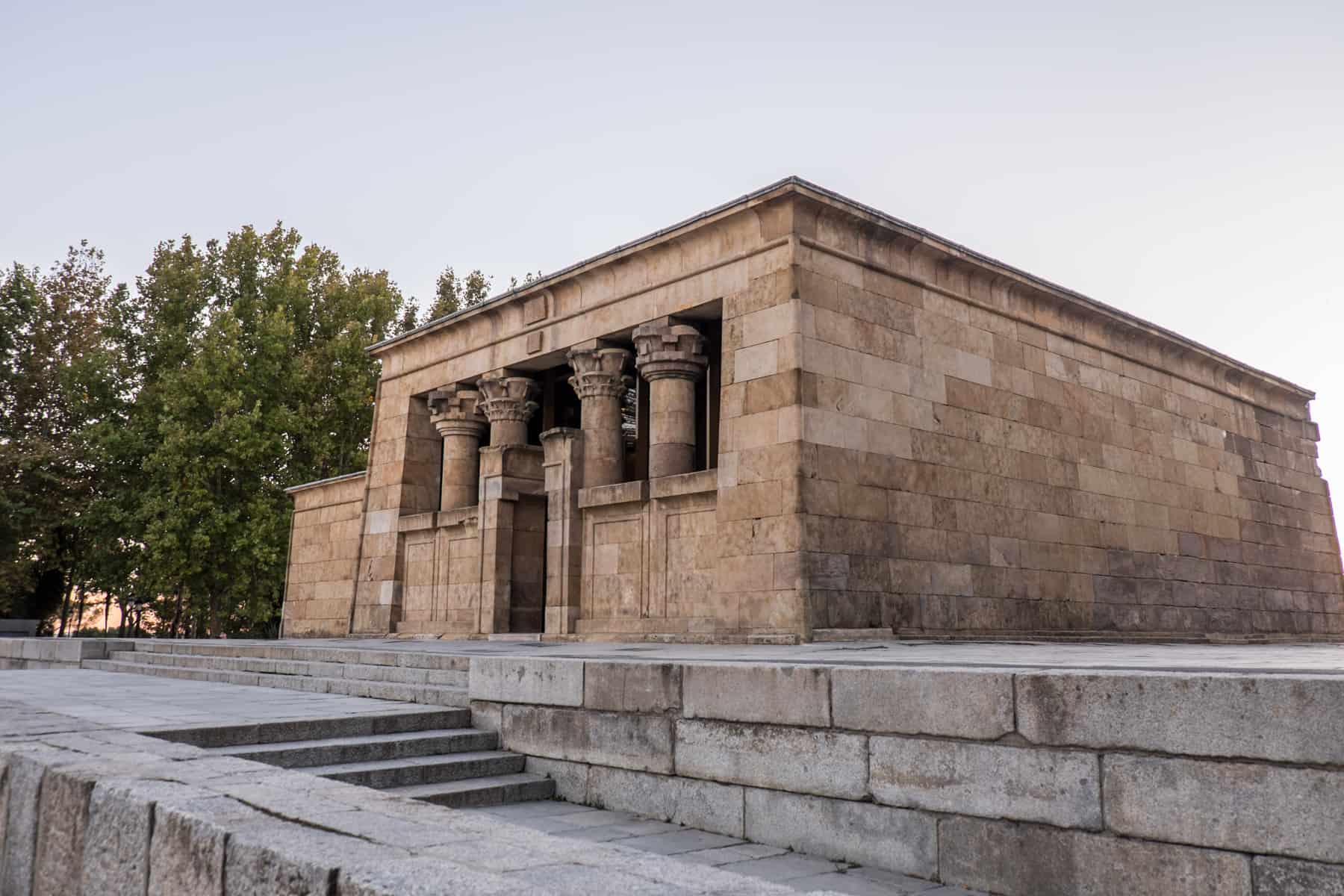
El Retiro Park (Parque del Retiro) dates back to the 19th century. It is Barcelona’s most beautiful city park, complete with a gentleman’s rowing lake, replica monuments, and botanical gardens. Next to Atocha train station, El Retiro Park also features Cybele Palace (Palacio de Cibeles), which is capped at a striking white crown-like spire on one end.
Art lovers can easily spend an entire weekend in one of the city’s 50 museums, almost half of which are art galleries. However, if there is one that stands out above the rest, it would have to be The Prado Museum, also known as Museo Nacional del Prado. I went on a guided tour of El Prado and it was mind blowing, considering the amount of European masterpieces housed there dating from the 12th through the 20th centuries.
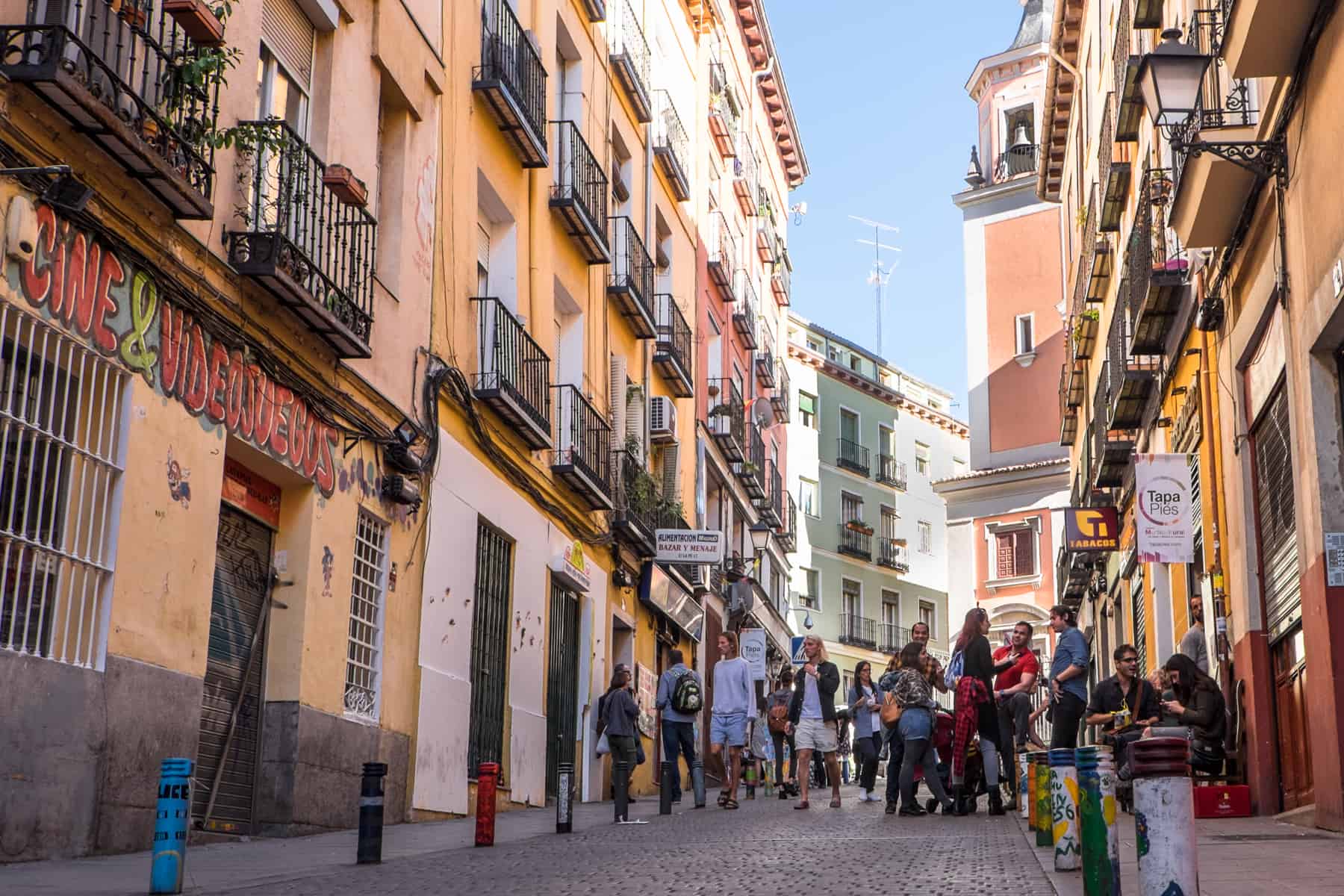
I’ve spent most of my time getting to know the outskirts of Madrid. This is how I personally prefer exploring the different layers of a city. Malasaña and Chueca are the trendy, stylish, boho parts of town, Lavapiés is the multicultural edgier neighborhood filled with street art, and La Latina is the heart of Tapas culture. Barrio de las Letras (the Literary Quarter) is a compact artistic hub where writers from the Spanish Golden Age used to live. Los Austrias is the historic neighborhood where you’ll find Plaza Mayor and San Miguel Market.
If you are short on time or want a different type of sightseeing, you can also tour Madrid in a nostalgic SEAT 600, or visit the highlights of the city on the hop-on-hop-off bus.
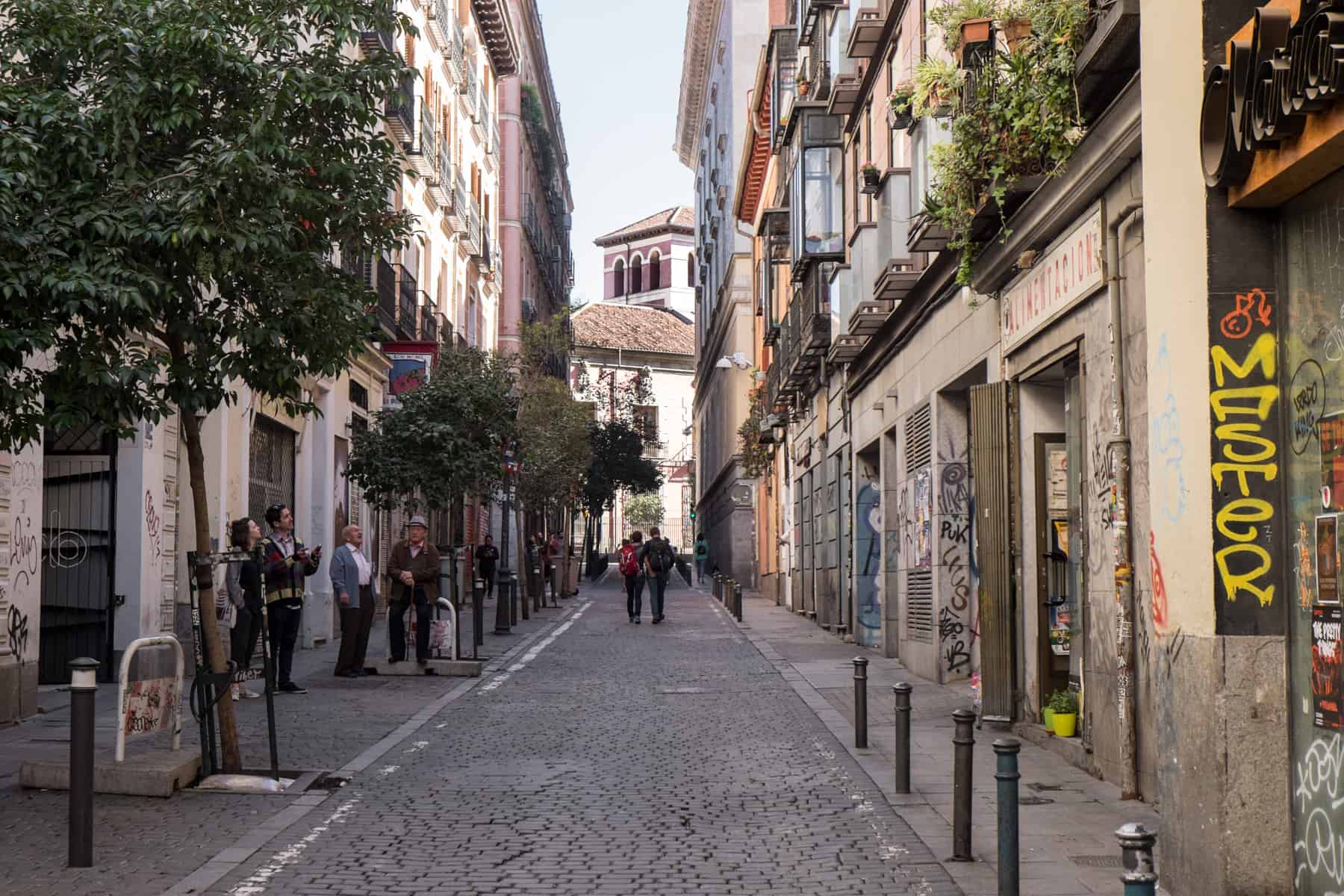
Spain Train Trips Starting From Madrid
Madrid to San Sebastian
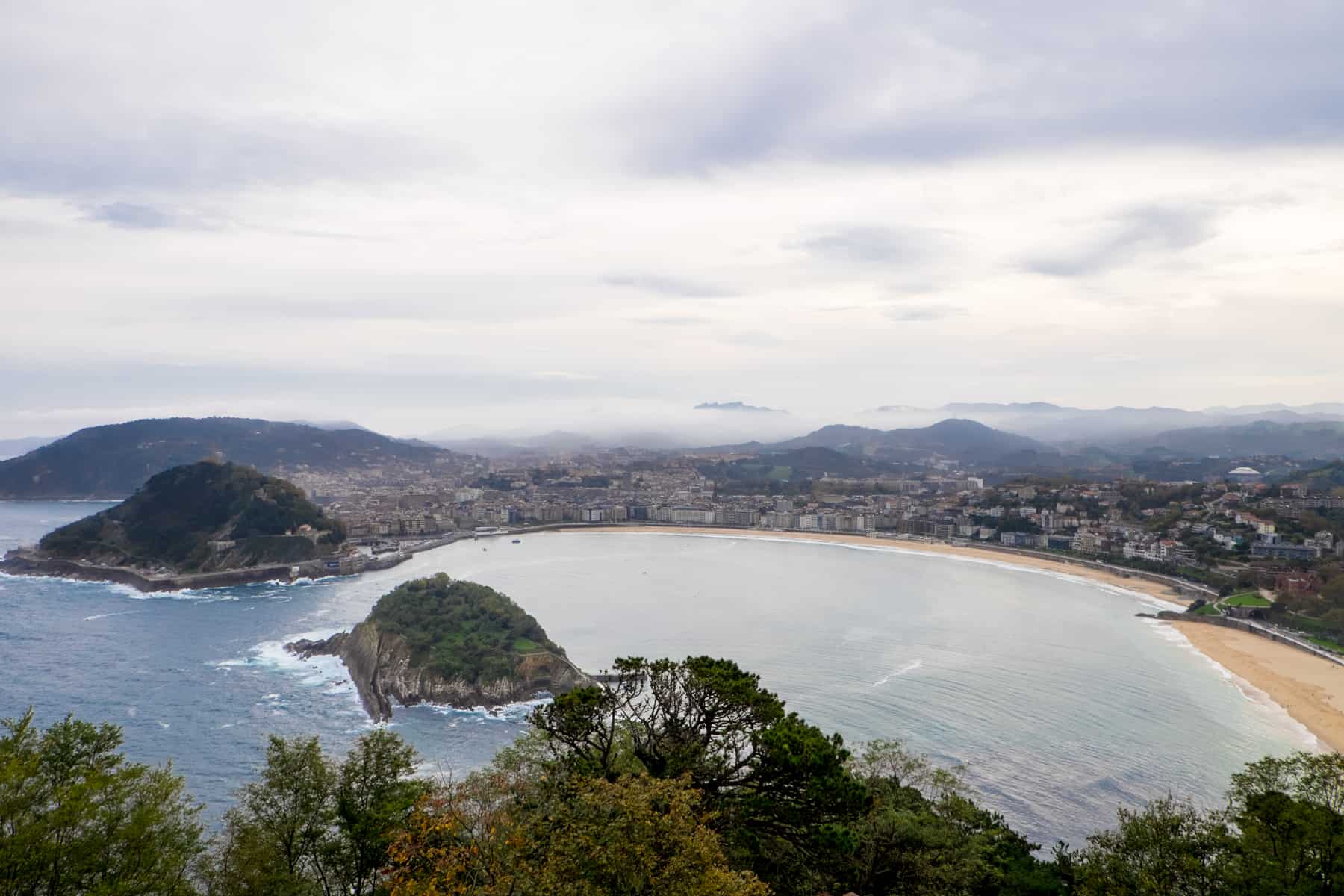
The coastal Spanish city of San Sebastian (or Donostia) locates you in a very unique part of Spain. It’s known primarily as a gastronomical city, but has plenty of Old Town architecture from Baroque basilicas to Belle Époque buildings, music, the arts, Balenciaga and some of the oldest traditions and languages of Europe’s Basque heritage.
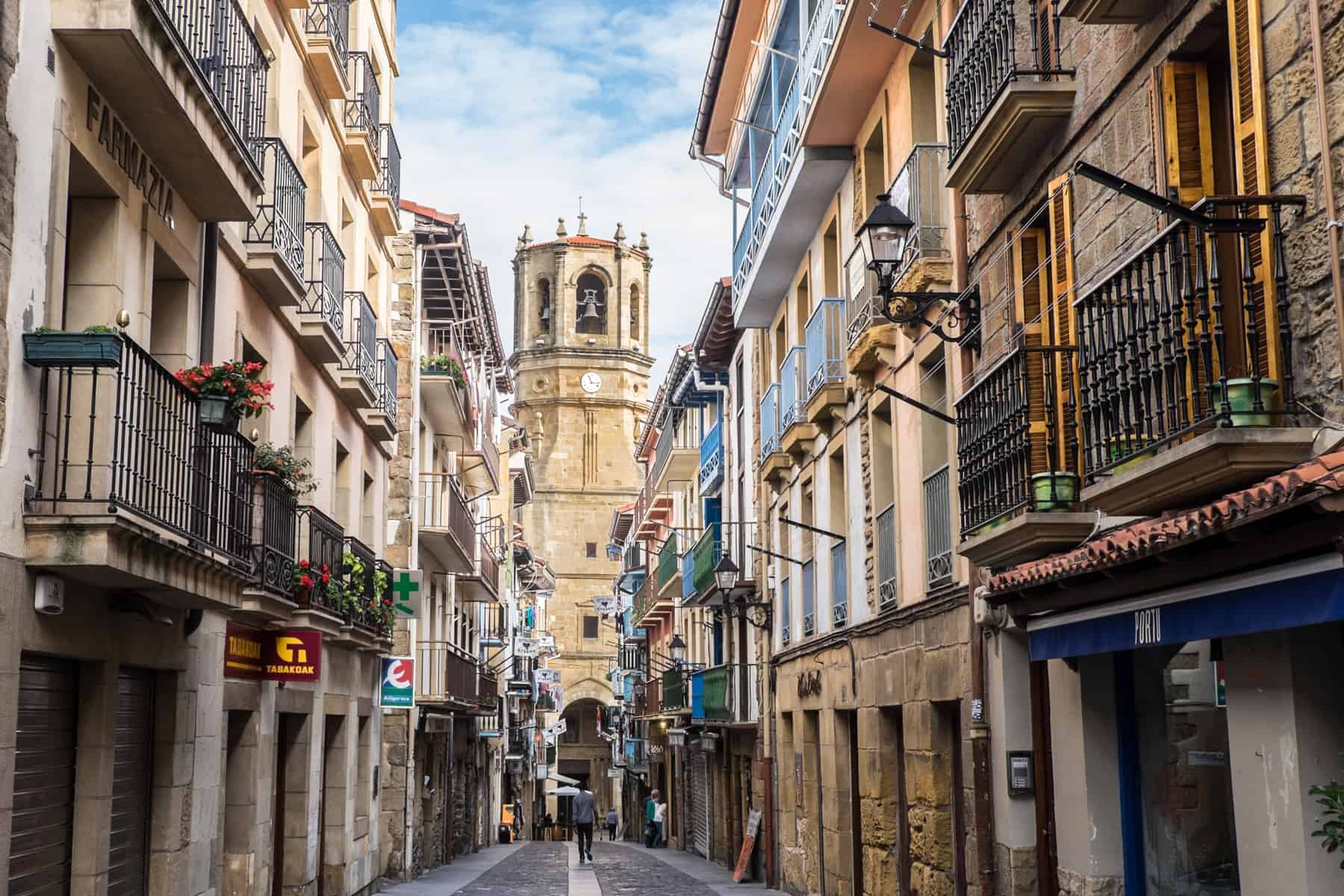

The oceanic city that used to attract Royals and Aristocrats for summer vacations San Sebastian has really made a name for itself. As a European Capital of Culture, the city offers everything from ambling along the beach to surfing and stand up paddleboarding. I saw the entire city from the top of the Igueldo mountain, then rode my bike through the city’s 30 km long dedicated cycling paths. Of course with all the indulging in Pintxos bar hopping there is, how could anyone resist?
Great guide, try out the Best Pintxos in San Sebastian: The Miniature Food Culture.
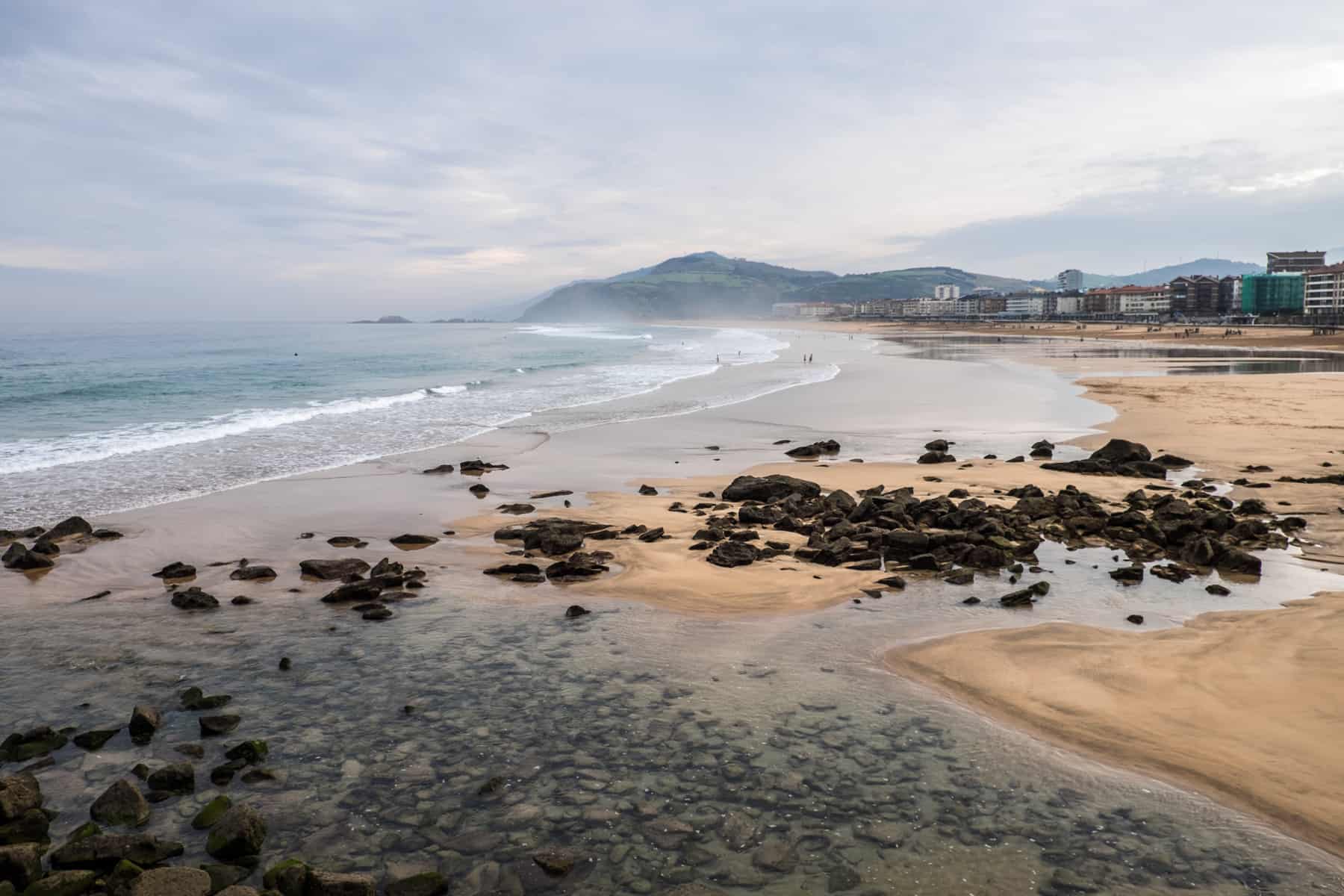
Madrid to Girona
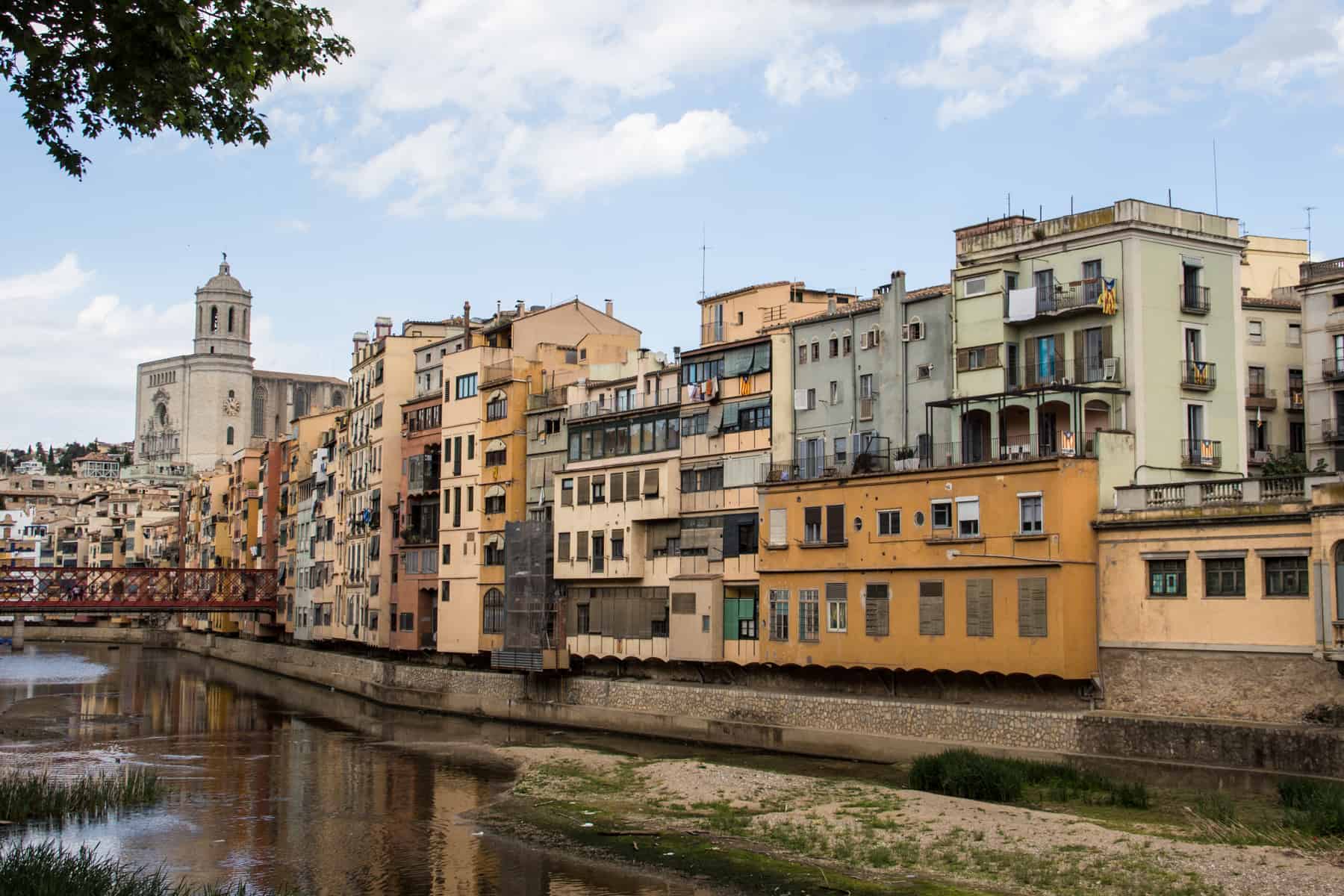
Madrid to Girona
Barcelona may overshadow the other cities in Spain but not too far away is Girona whose medieval old town with its fortified walls and narrow alleys captures the essence of over two thousand years of history. The secluded beaches of Costa Brava are also just 30 minutes away.
Exploring the Old Quarter (Barri Vell) will take you to the process of conjoining the history of Rome and Medieval Europe. The Força Vella fortress is a remnant of a 1st century BC walled fortress built by Romans and has some walkable ramparts. You can go on a premade walking tour to find the various Game of Thrones filming locations.
Visit the city to see the Eye of Girona, the famous Cathedral with its Romanesque tower and baroque facade, the stunning Islamic-like made architecture of the Arab Baths built by Christians in 1194 and the Peixateries Velles bridge, painted bright red and erected in 1827. It serves as an important landmark of the city.
Things to Do in Girona – Explore Spain’s Hidden Historical Gem
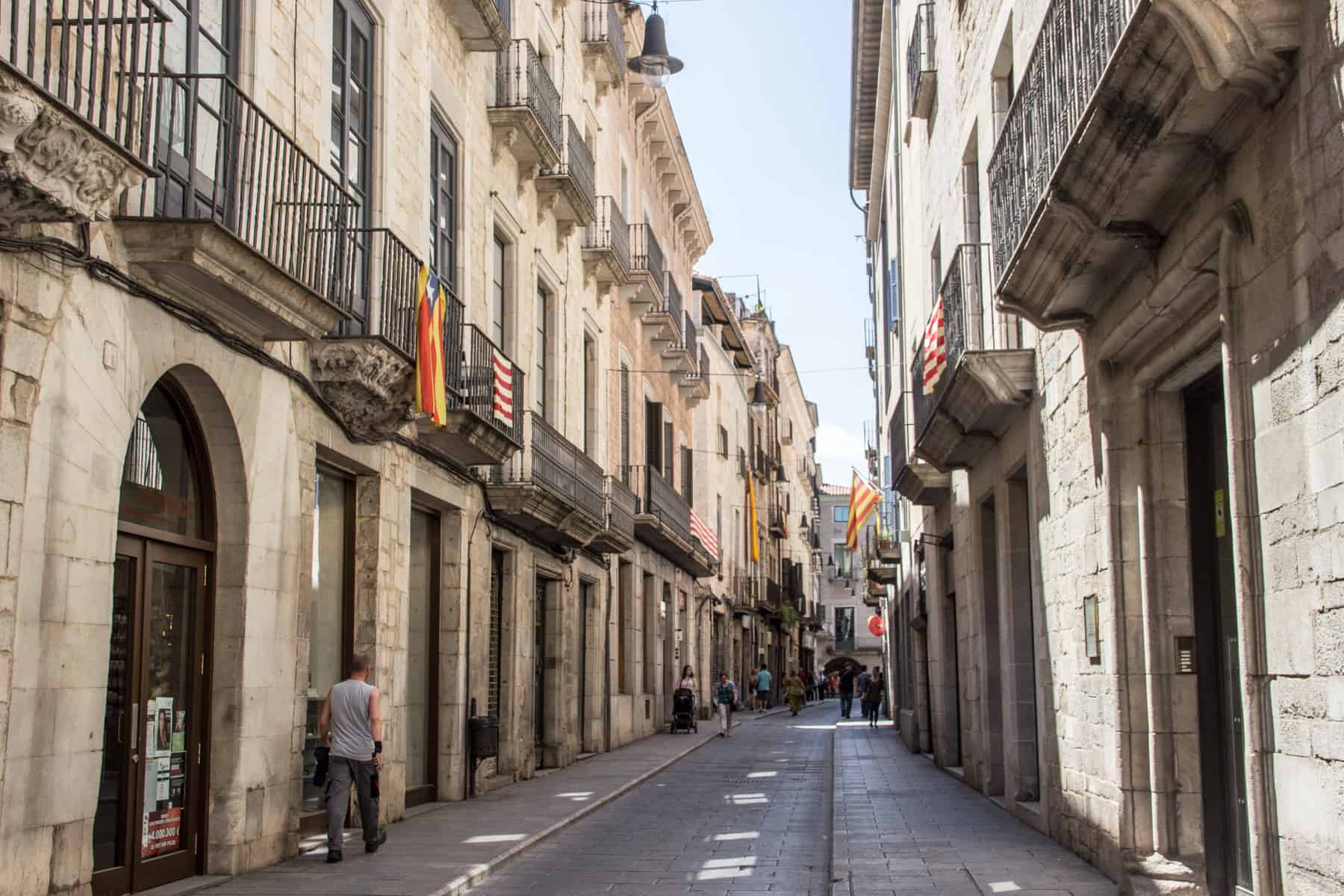
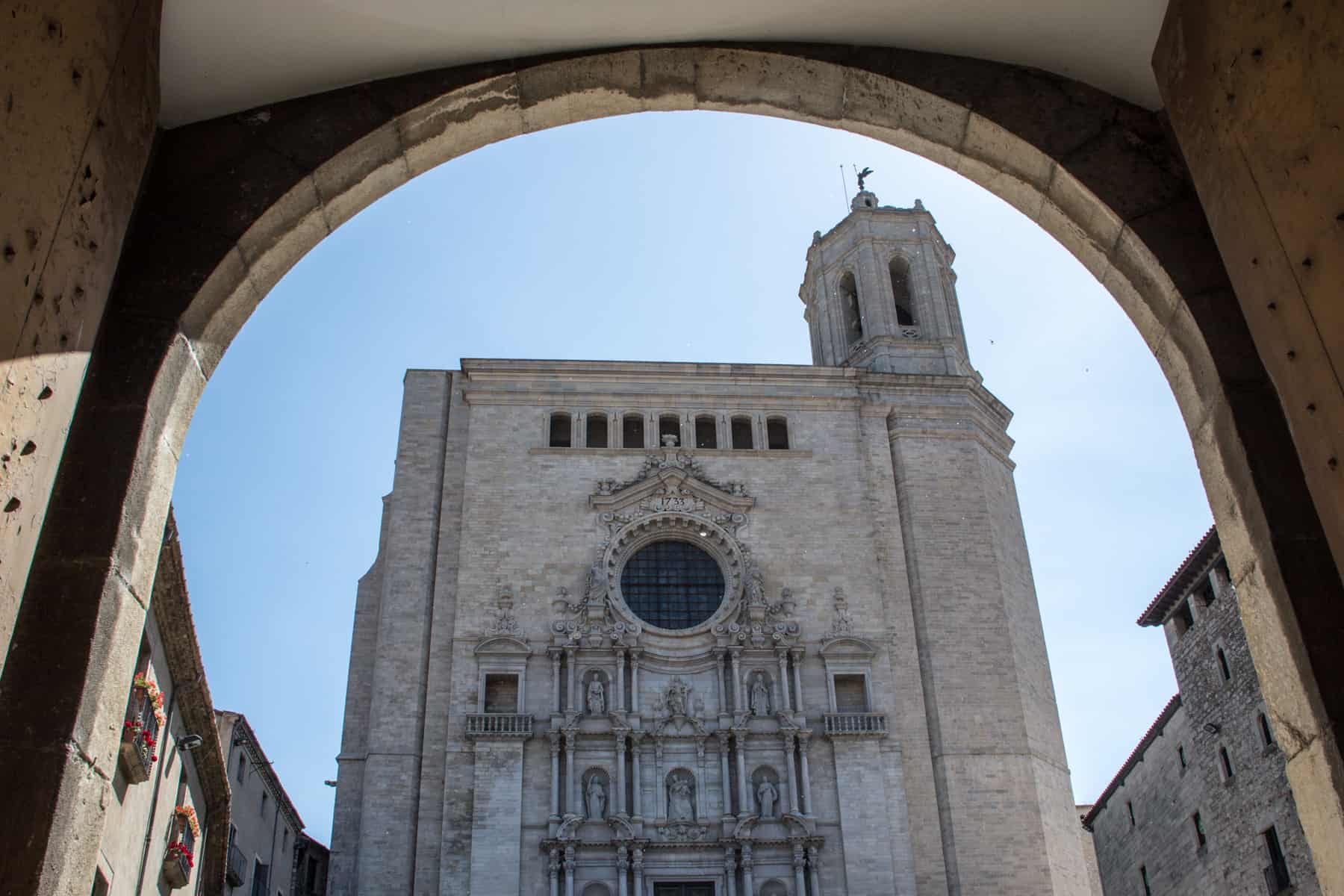
Madrid to Zaragoza
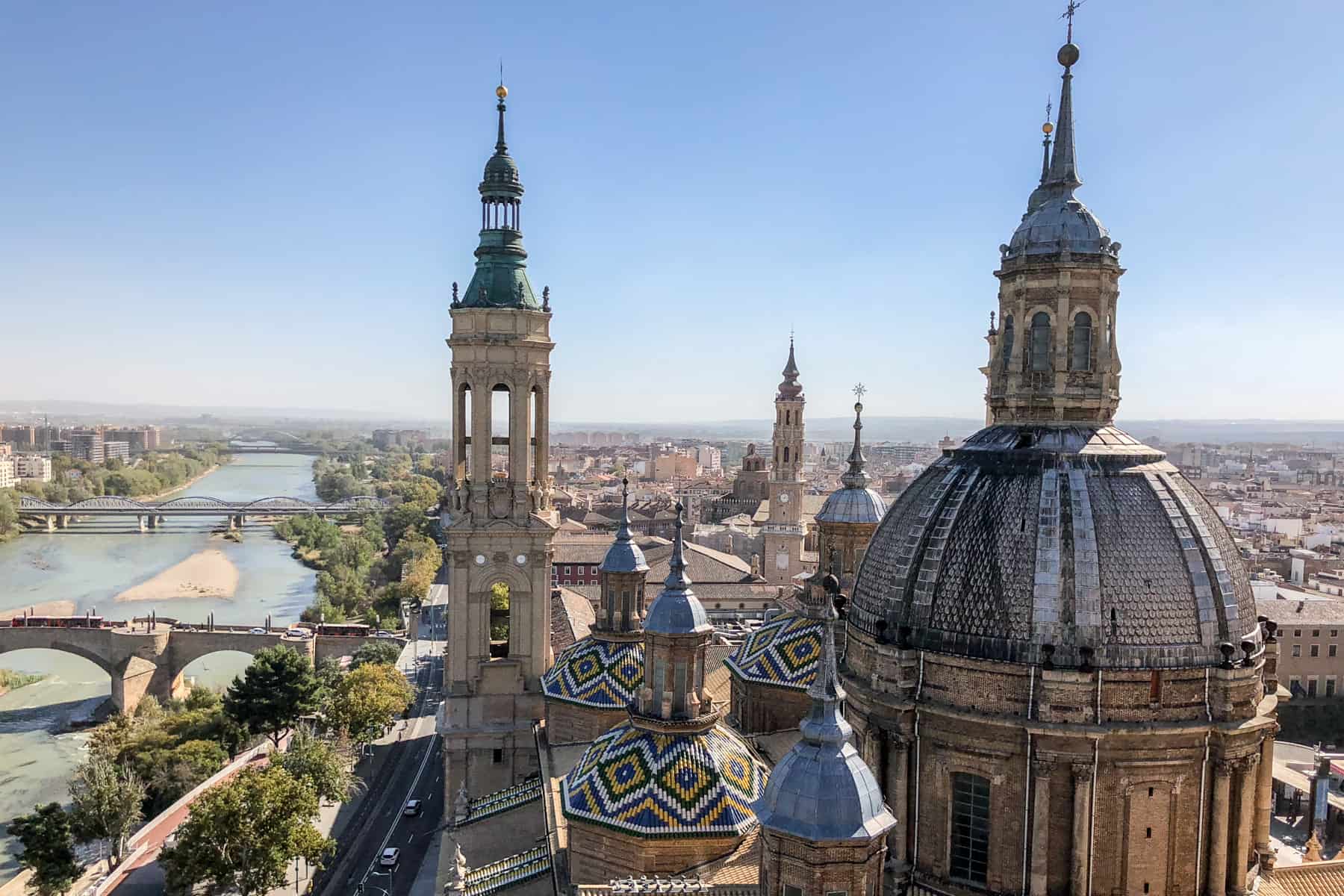
North East Spain has an Aragon region which acts as a link between Madrid and Barcelona. The compact city of Zaragoza is a candidate for your day trip. It is striking how modern urban development coexists alongside the graceful old part of town.
The most emblematic monument to visit is the 11th-century medieval Islamic Ajafería Palace. Zaragoza has been designated a UNESCO World Heritage Site due to this example of Mudéjar art which is so characteristic of Aragon. Moreover, it soars above the city’s skyline, alongside the Roman Catholic Cathedral-Basilica of Our Lady of the Pillar. You will also notice that street art marks the beginning of the alternative side of the city.
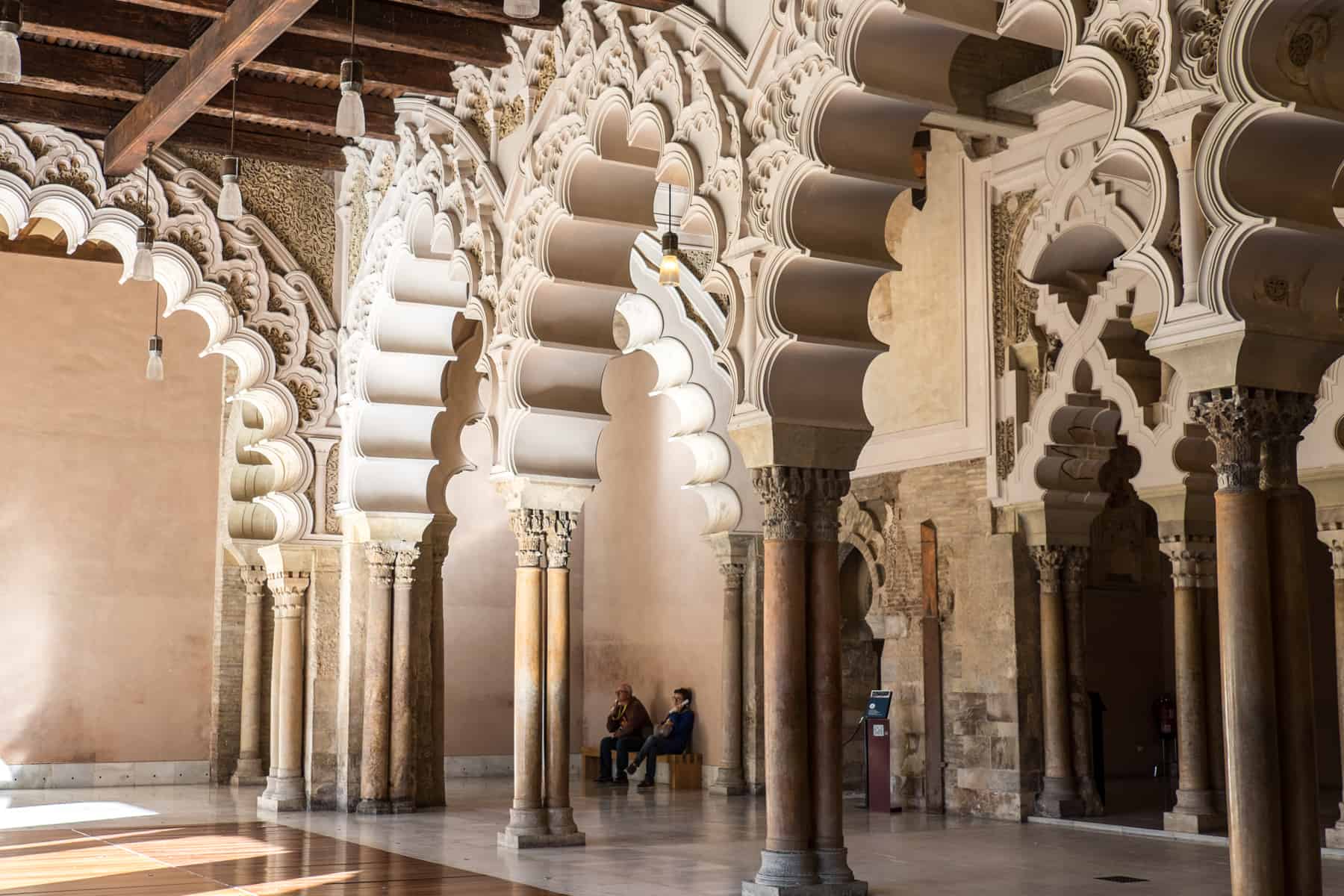
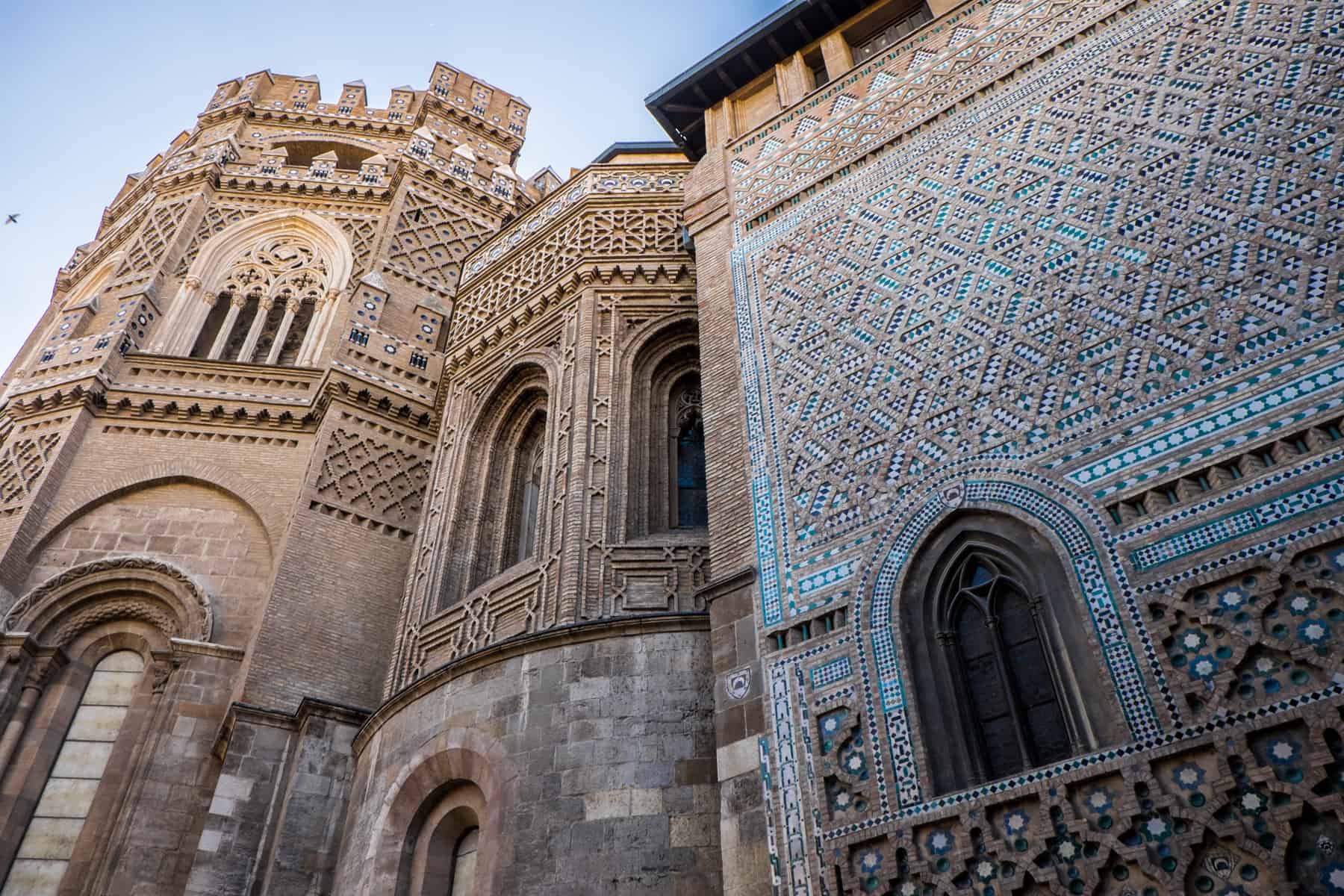
The stunning mural covered buildings are part of a yearly civic improvement program aimed at transforming neglected areas into artistic attractions. In Goya’s home, with a dedicated museum of his works to boot, it’s no wonder that art plays a central role in the city’s persona. For the second part of Aragon’s political and economic heart, ultra modern decoratives still dominate the landscape like the Alma del Ebro sculpture at the Zaragoza Expo Zone.
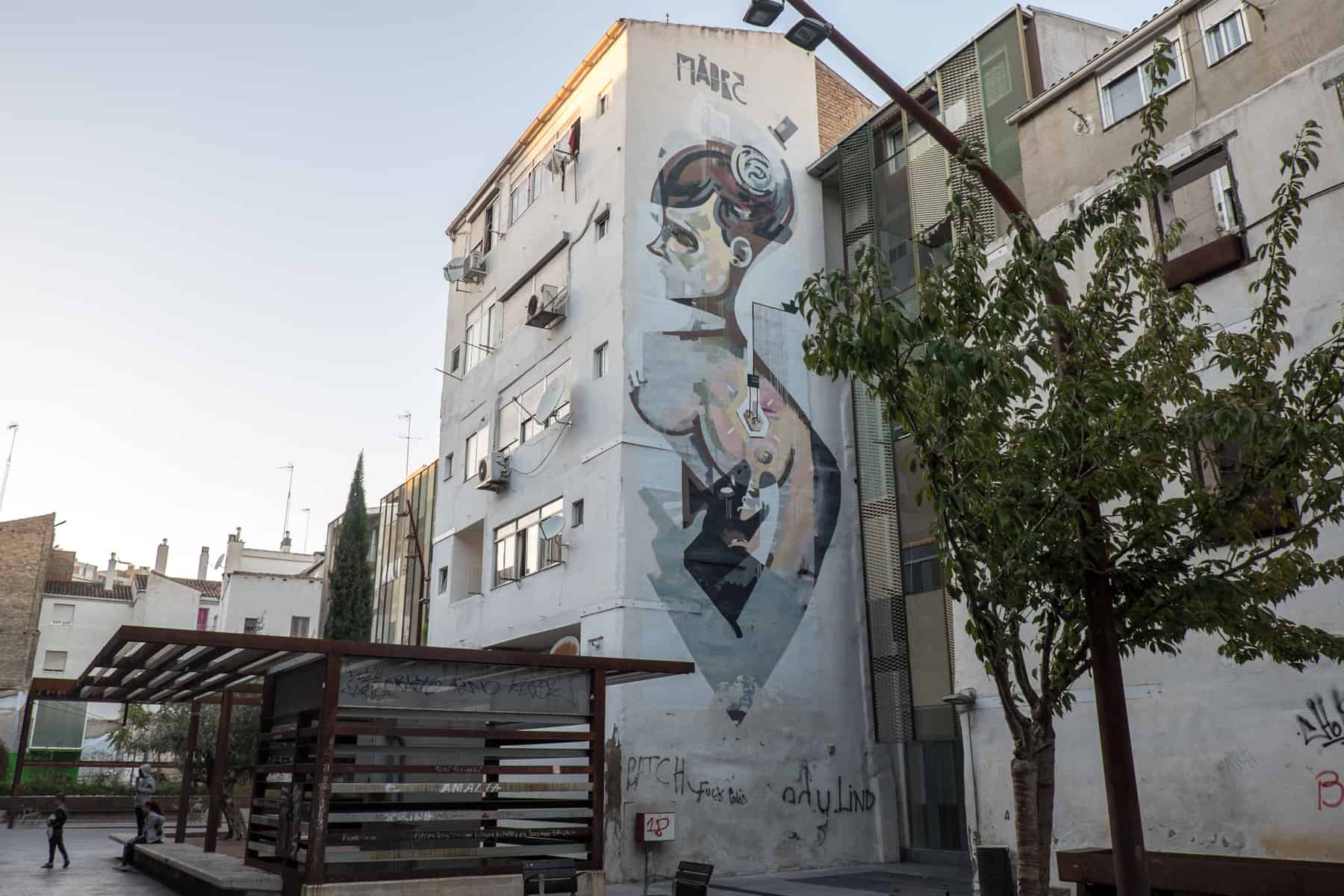
Madrid to Barcelona
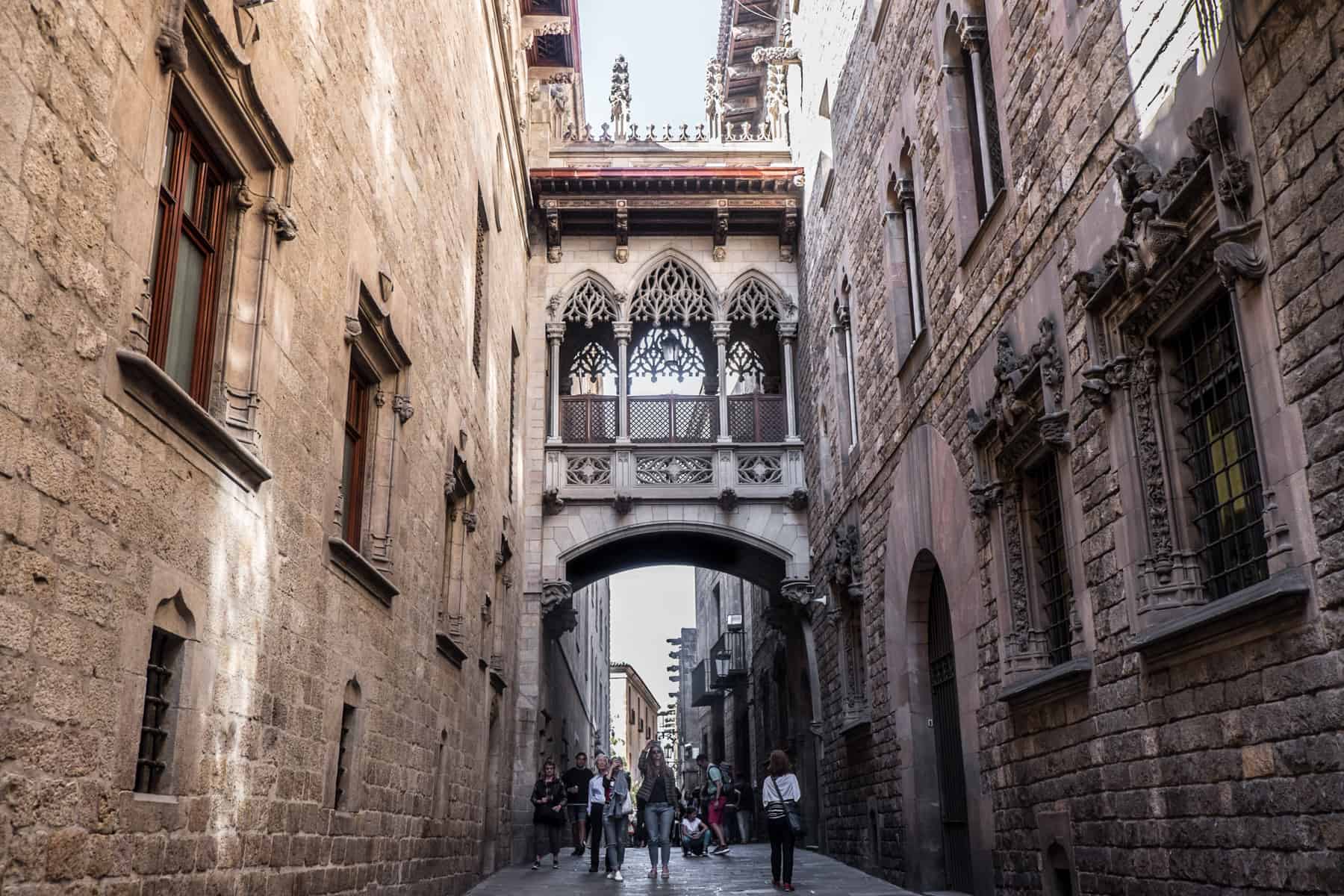
World Heritage Visit Zaragoza, Spain, Legacy, and Urban Renewal Having a ← Madrid to Barcelona → claim my favorite long distance train ride in Spain is the one that connects the capital Madrid to the coastal capital of the Catalan region Barcelona. A must visit for sangria lovers. I have been to Barcelona twice and each time managed to discover new major sites without rushing, exploring and strolling through long boulevards, Barcelona bike tours, beach days and long catalonian evenings. For any traveler, a walk on the kilometer long Las Ramblas is a rite of passage and Gaudi’s architectural creations serving as landmarks, visiting the Sagrada Familia, egg white carved Casa Mila, the mosaic wonder that is Casa Batlló and Park Güell, and in the Gothic quarter(Barri Gotic) get lost in an incredible labyrinth of narrow streets, medieval squares and striking gothic façades. Visit Barcelona and don’t forget to shop for local produce from fresh seafood, jamón ibérico and cheese at the market institution that is La Boqueria and catch the bus to one stretch of La Barceloneta; the long yellow sand stretch and promenade of Barcelona’s city beach.
How to Get from Madrid to Valencia
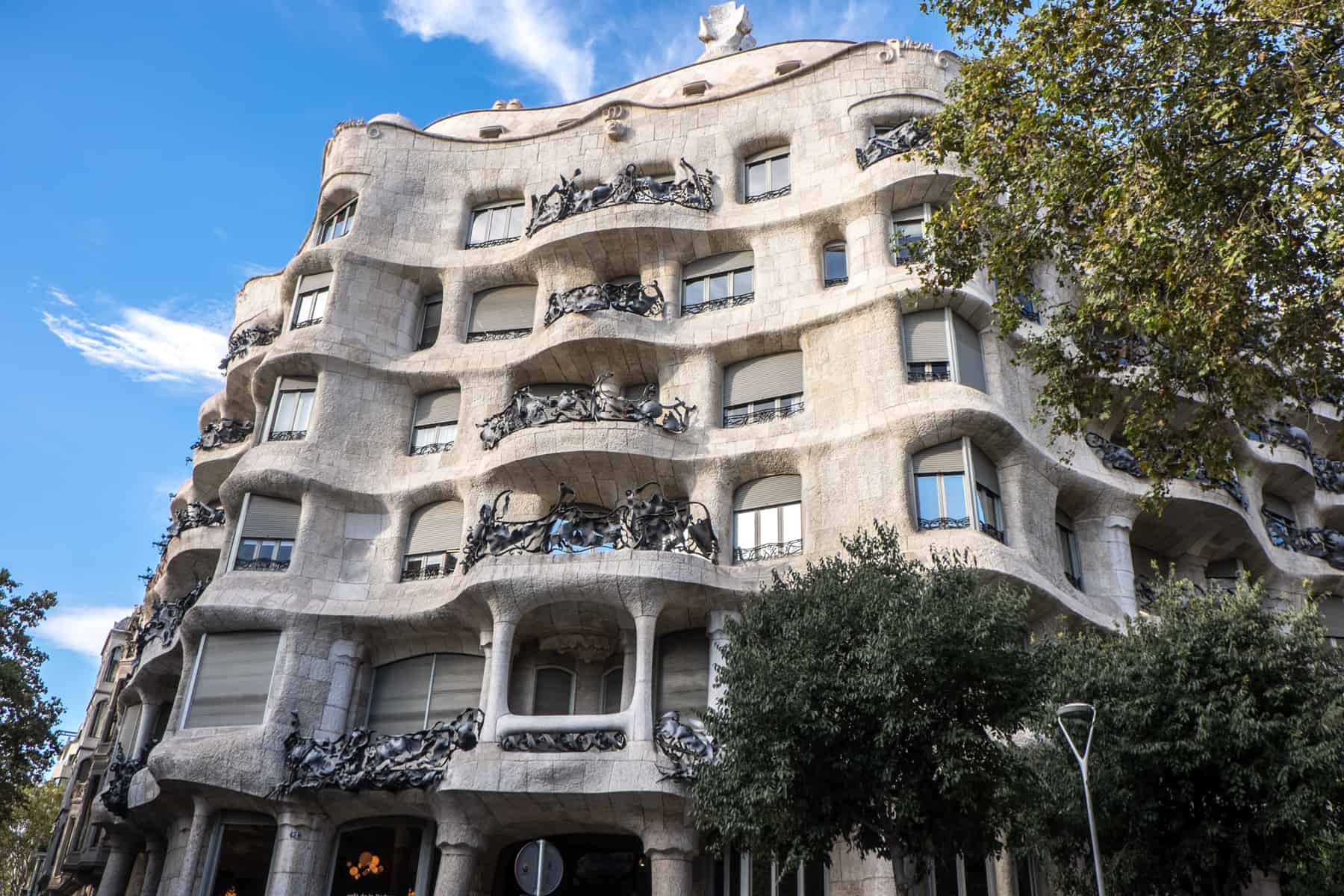
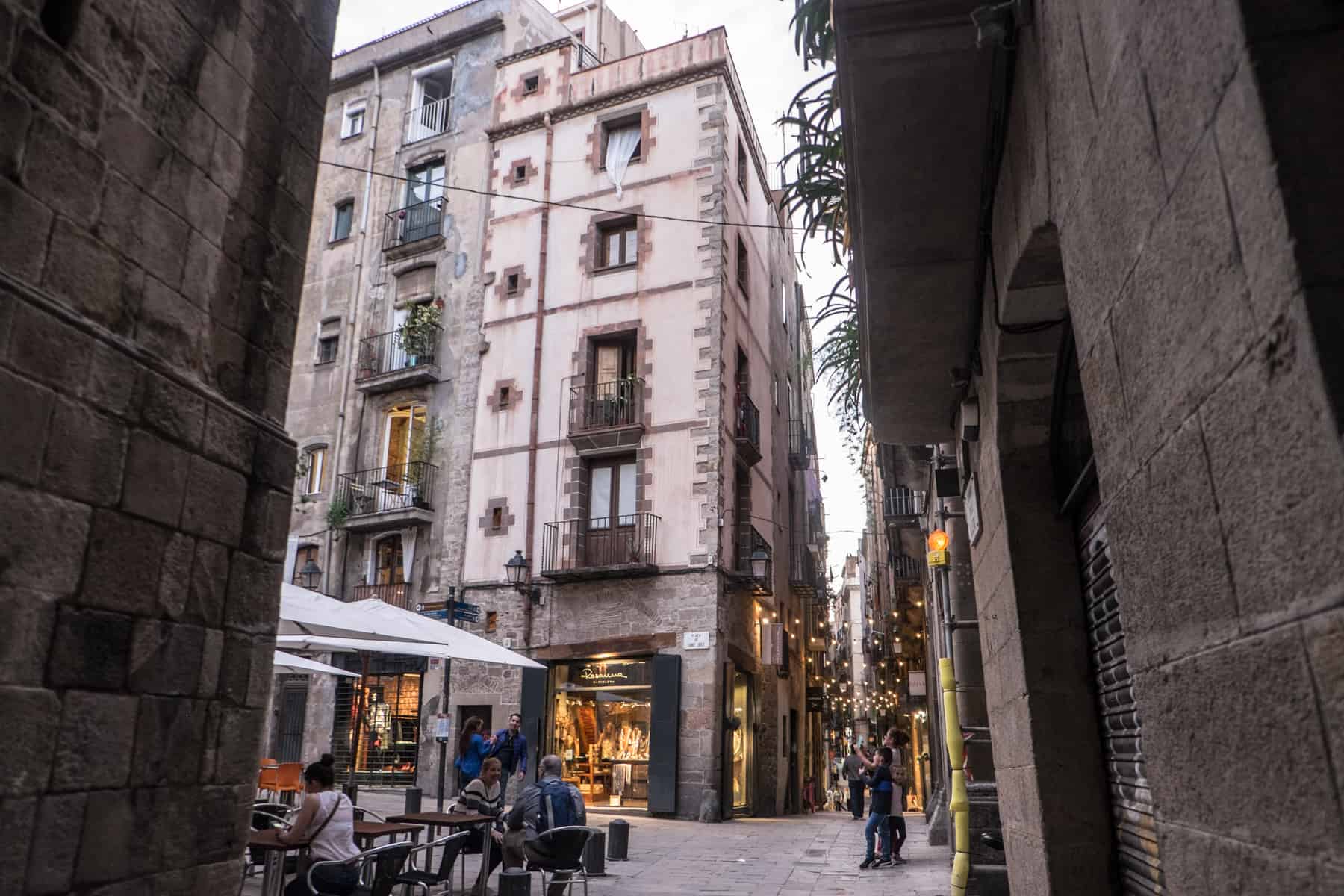
Madrid to Valencia
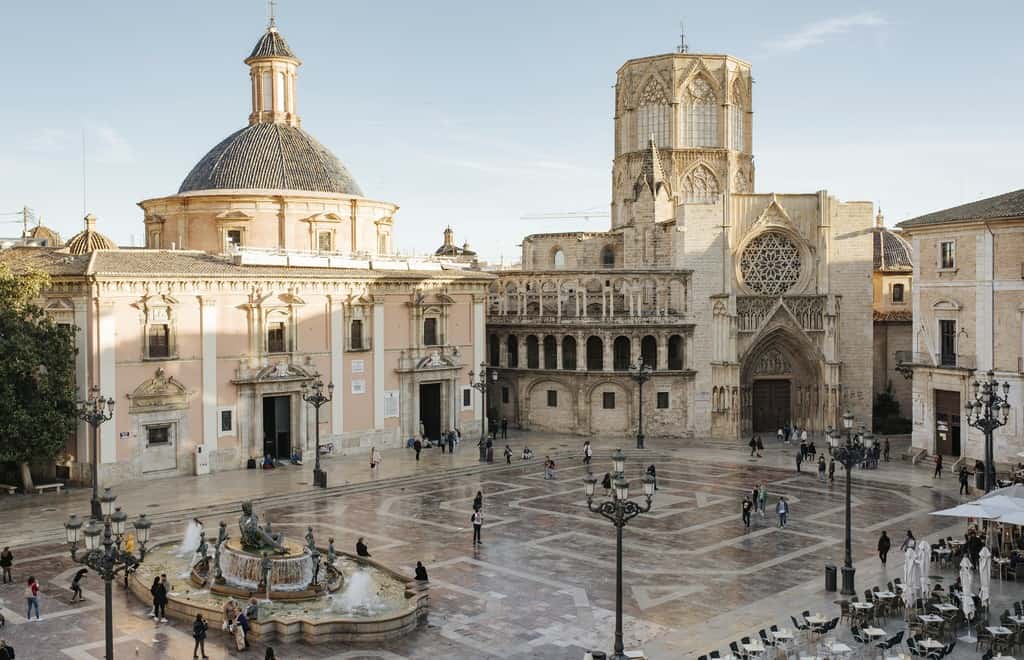
© VisitValencia
The UNESCO World Heritage city of Valencia is one of Spain’s oldest, a trip that combines a heritage of 2,000 years with a Mediterranean climate and fine powered sand beaches.
Valencia is a city full of accolades. Start in the Old Town’s cobblestoned labyrinth (Ciutat Vella). The historically layered Roman, Gothic, Baroque Cathedral protects the Holy Chalice and the Silk Exchange (La Lonja) World Heritage Site displays why it is one of the famous civil gothic monuments in Europe. The 1000-year-old neighborhood of Barrio del Carmen, whose Muslim and Christian walls whose gates still stand, preserves some of the city’s iconic medieval structures like the Serrano and Quart Towers.
For food and nature, the Central Market in Valencia, with its 1200 food stalls, is the largest market with fresh produce in Europe. The wetland oasis of L’Albufera National Park is where the famed culinary paella was invented. Valencia’s port area trio of museums, known as the City of Arts, connects to the Turia Gardens. This city park’s extensive network of tree-lined footpaths, lakeside recreation spots and 18 bridges in different architectural styles makes it one of Spain’s largest urban parks.
Madrid to Córdoba
A trilogy of cultures from its founding as a Roman city to Arab conquest and Christian rule, the golden stoned Córdoba is an ancient architectural marvel. In preserving this legacy, Cordoba holds the title of the first city to have four UNESCO World Heritage Sites – more than any other city in the world.
Visit the Mosque-Cathedral, La Mezquita – the most famed of the four UNESCO World Heritage Sites as a distinguished monument of Islamic architecture, alongside the notable Historic Centre and Jewish Quarter surrounding it. Also included are the excavated ruins of the Caliphate city palace at the foot of the Sierra Morena Mountains, which ruler Abd-al Rahman III had constructed in 929 AD to display his Kingdom’s power. The beautiful domestic courtyards symbolic of Córdoba and its acclaimed Festival of the Patios, which open the private community spaces for public viewing, are a UNESCO Intangible Cultural Heritage of Humanity site.
Other interest sites include touring the fortress turned Royal residence, Alcazar de Los Reyes Cristianos and the 1st century BC Roman Bridge over the Guadalquivir River. The former Moorish Calahorra Tower at the end is today a museum detailing the long history of conquest and achievement in the city.
Madrid to Seville

From bustling Madrid to the charming, flamenco-dancing famed Seville, this city is where the colorful, artistic streets converge with the delicate, classical architecture of the open squares and boulevards. As Andalusia’s capital, and another of the most popular trips from Madrid by train, it will most likely be your introduction to the region too.
The Cathedral is a city centerpiece, as the exquisite Plaza de España is a plaza in the Parque de María Luisa. A mix of Islamic and Renaissance designs, this 1928 masterpiece symbolizes the city known for its grandeur of tiled fountains, opulent bridges and lush gardens. Dedicate at least half a day to exploring the vast landscapes and vivid detail of the stunning Mudéjar architecture of the Real Alcázar of Seville, a 14th-century royal palace built by Muslim Kings.

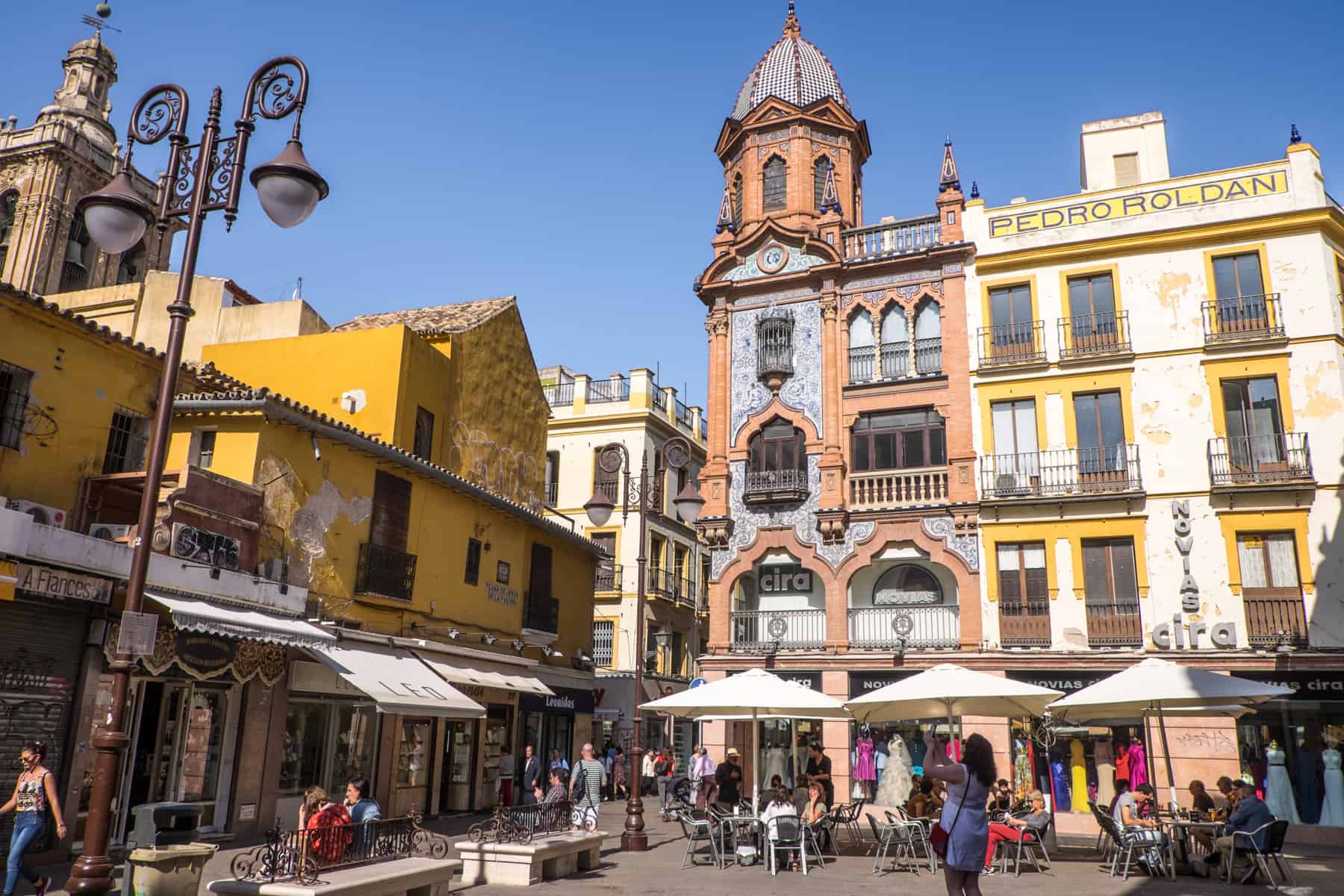
Seville is not without its modern architectural additions. Occupying one of Seville’s squares, the city’s Metropol Parasol (more affectionately known as ‘the mushrooms’) is the largest wooden structure in Europe, whose curling walkways up to 26 meters high provide a new panoramic view of the city. Designed by German architect Jürgen Mayer, it has been controversial since its completion in 2011.
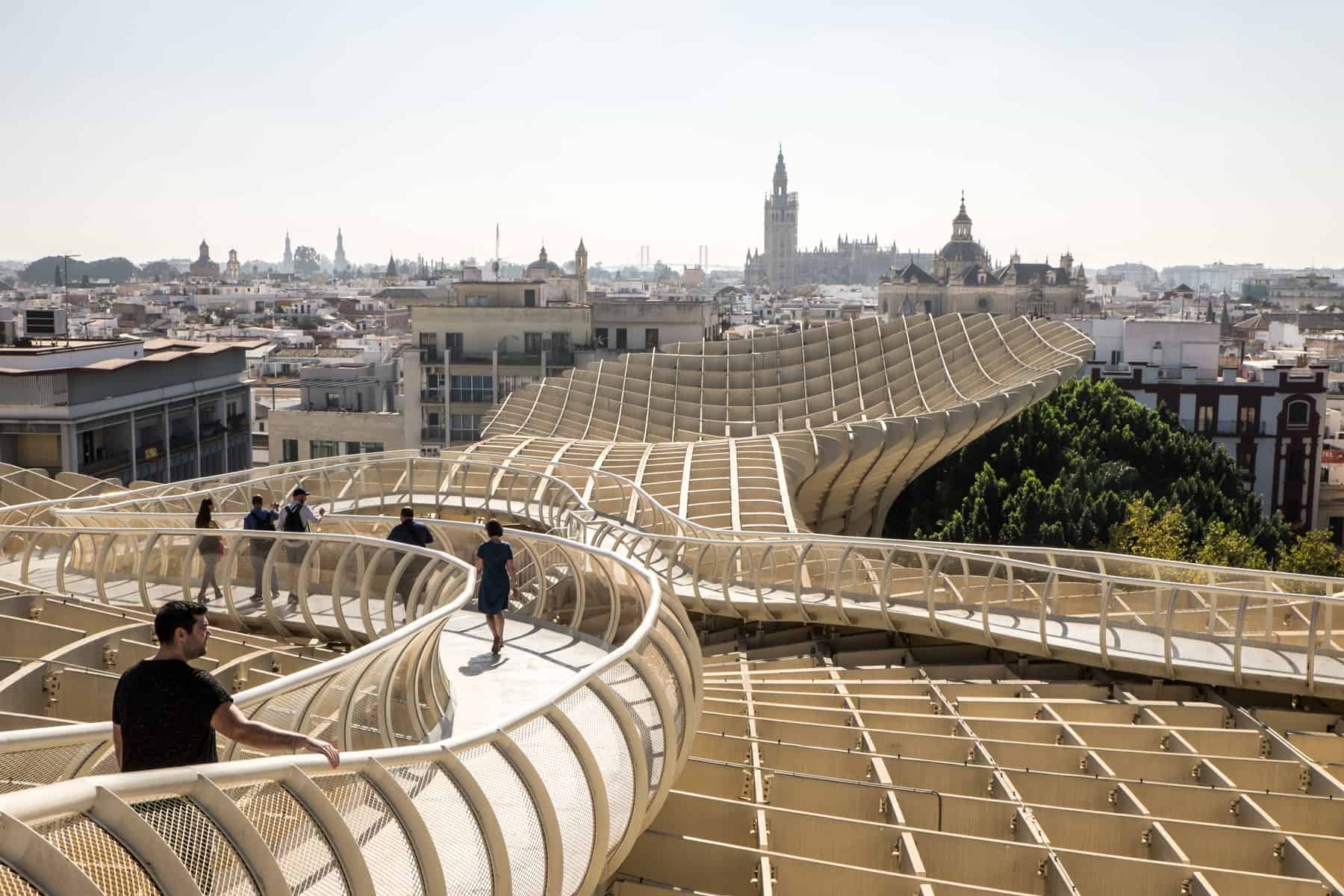
Madrid to Granada
Granada’s icon is the fortified Arab citadel of the Alhambra, perched defiantly in the Sierra Nevada Mountains. An opulent tiered, tiled and terraced complex of palaces, courtyards and gardens, it is preserved as one of the finest examples of Islamic architecture on the continent.
In the Historical Centre of Granada city, Catholic architecture takes centre stage, including the Renaissance masterpieces of the Cathedral of Granada and the Monasterio de San Jerónimo, alongside the baroque Basilica San Juan de Dios and the Capilla Real (Royal Chapel) mausoleum of the last Catholic Monarchs. Admire the cave houses of Sacromonte and join the buzz at Campo del Prínicpe Square in the Jewish neighbourhood of Realejo-San Matias and indulge in the tradition of free tapas in Granada, for which a complimentary morsel is given with every drink ordered.
Adjacent to Centro Granada, spend time getting lost in the streets of Albaicin, granted UNESCO World Heritage status for its traditional Moorish architecture and courtyards and kicking back in the hum of the atmospheric Arabic teahouses.
Madrid to Malaga
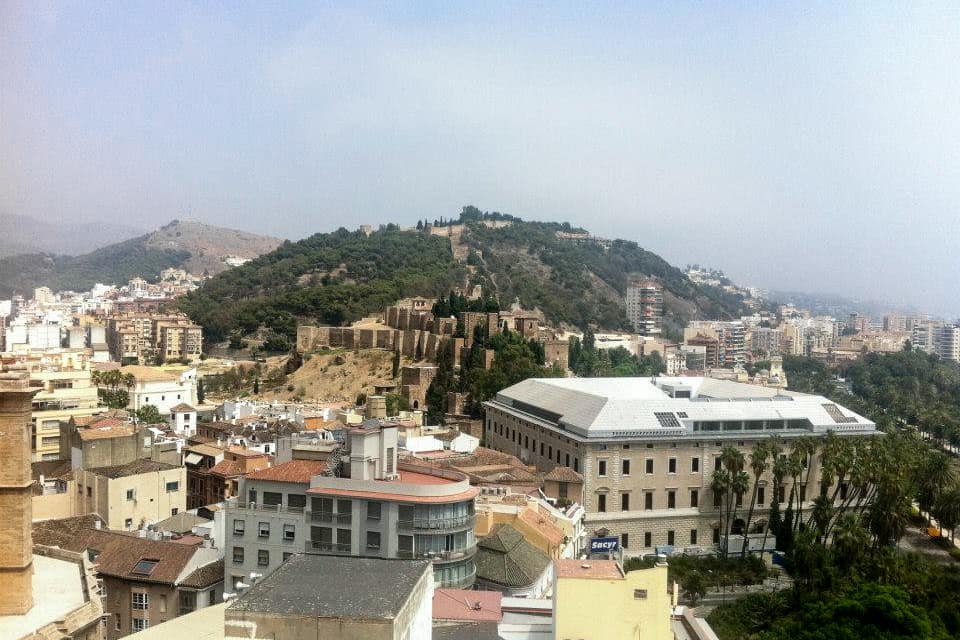
The fashionable city of Malaga on the golden sand southern coastline of the Costa del Sol is one of the world’s oldest cities. Its pre-historic 3,000 years of history go back to its founding by the eastern Mediterranean Phoenicians in the 7th-century BC. Today, Malaga is best known as the birthplace of the revered artist Pablo Picasso.
History stands at the base of Gibralfaro hill with the preserved palace structure of Alcazaba of Málaga, a Muslim monument partially constructed in 1057 using stone materials from the 1st century AD Roman Theatre that stands in front of it. The hilltop Castillo de Gibralfaro Castle was built to protect the Alcazaba, captured in 1487 by the Catholic Monarchs during the Reconquista that drove out the Moors and used as a residence by the King. Visitors also come here for the sweeping views over the city. Monuments from the Christian era of Malaga include monasteries and basilicas and the commanding Renaissance allure of the Malaga Cathedral (Catedral Nuestra Señora de la Encarnación).
Art enthusiasts can follow Picasso’s trail at number 15 Plaza de la Merced – the building where he was born in 1881 – before heading to the 16th century Renaissance beauty of Buenavista Palace, home to the Museo Picasso Málaga (Malaga Picasso Museum). Break up a tour of Malaga’s highlights with a trip to one of the 15 city beaches.
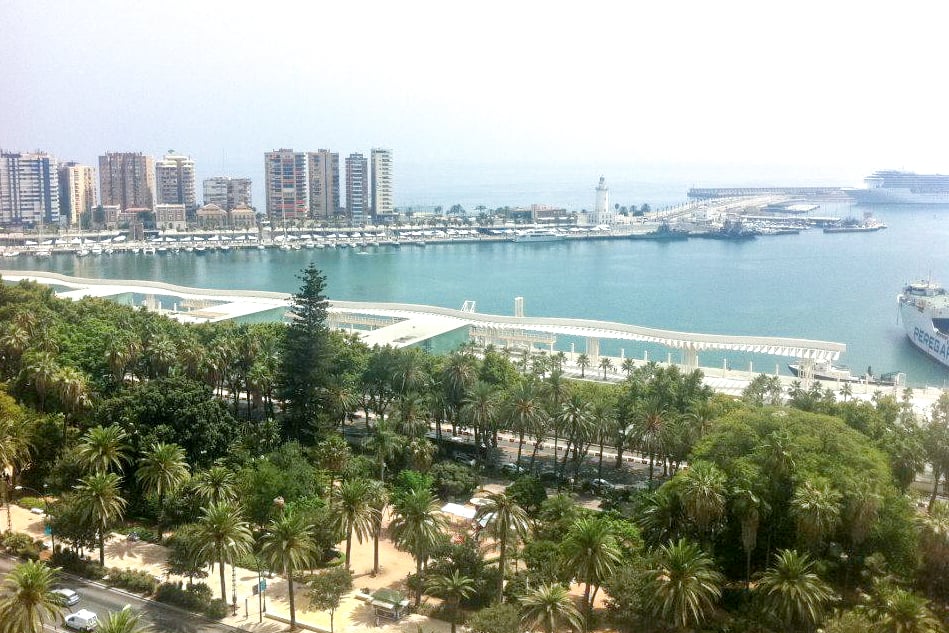
Tips for Planning Spain Trips
When to Go
The best time for this trip, based on optimal weather conditions, are the shoulder ends of May-October, based on all the average forecasts for Madrid, San Sebastian, Girona, Zaragoza, Barcelona, Valencia, Cordoba, Seville, Granada and Malaga.
Traveling from Madrid by Train
All train tickets for the AVE rail network have to be pre-booked since you can’t turn up on the day and book at the station. You can show tickets electronically via a smartphone. There are nine classes, of which Turista (a second class option with 2 x 2 seating rows) and the more spacious Turista Plus (with 2 x 1 seating rows) are the most common and cost-effective.
If you are booking a multi-stop trip, consider getting a ‘Spain Pass’. This means you can travel using just one ticket for the AVE and other long-distance trains. You must reserve a seat before every trip, as limited space is assigned for Spain Pass holders.
Disclaimer: This article was created in collaboration with the Tourism Office of Spain as inspiration for when we can travel again. For further Spain travel advice and help planning your trip, visit Spain’s official tourism portal. Borders of Adventure maintains full editorial control of the content published on this site.
Photos of Malaga by former local David Brennan and an image of Valencia were used with permission from the Spanish Tourist Office in London for this campaign.
If you are considering a trip, there are many places to go in Spain that you should explore. Whether you love the beach, the mountains, or cultural cities, Spain has something for everyone.
Plan your trip to Spain with these resources.
Read Next: Why I Choose the Window Seat- I am a Nervous Flyer.

